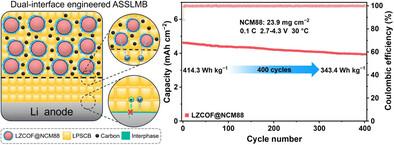Scalable Dual‐Interface Engineering for High Ionic Conductive, Mechanical Robust Sulfide Membranes in High‐Energy All‐Solid‐State Li‐Metal Batteries
IF 26
1区 材料科学
Q1 CHEMISTRY, PHYSICAL
引用次数: 0
Abstract
All‐solid‐state Li‐metal batteries (ASSLMBs) integrating sulfide electrolyte membranes with Li‐metal anodes and Ni‐rich layered cathodes represent a pragmatic strategy for realizing the elusive 400 Wh kg

高能全固态锂金属电池中高离子导电、机械坚固的硫化膜的可扩展双界面工程
将硫化物电解质膜与锂金属阳极和富镍层状阴极集成在一起的全固态锂金属电池(asslmb)代表了实现难以实现的400 Wh kg - 1的实用策略。然而,它们的实现受到电极/电解质界面不相容加剧和机械故障的困扰,这些故障会降低能量输出和循环稳定性。本文提出了一种多功能双界面工程范例,该范例结合了具有良好锂金属相容性的Li5.3PS4.3ClBr0.7 (LPSCB)电解质和具有优越阴极相容性的Li1.75ZrCl4.35O0.5F0.4 (LZCOF)电解质。坚固的40 μ m厚的LPSCB膜具有超高的离子电导率(3.05 mS cm - 1)和枝晶抑制能力(临界电流密度达到1.5 mA cm - 2)。同时,通过球磨,将微米级LZCOF颗粒均匀地包裹在lini0.88 co0.06 mn0.060 o2 (NCM88)阴极上,大大减轻了界面降解。因此,配置良好的LZCOF@NCM88/LPSCB膜/锂电池表现出卓越的快速充电能力(1.0°C下136.1 mAh g - 1)和容量保持能力(0.5°C下1000次循环后保持88.9%)。此外,在30°C下,ASSLMB在4.62 mAh cm−2的高负载下获得了414.3 Wh kg−1的显著电池级能量密度,并保持了400次循环的稳定性。这项工作代表了一种可扩展的双界面工程策略,使硫化物膜能够用于高能asslmb。
本文章由计算机程序翻译,如有差异,请以英文原文为准。
求助全文
约1分钟内获得全文
求助全文
来源期刊

Advanced Energy Materials
CHEMISTRY, PHYSICAL-ENERGY & FUELS
CiteScore
41.90
自引率
4.00%
发文量
889
审稿时长
1.4 months
期刊介绍:
Established in 2011, Advanced Energy Materials is an international, interdisciplinary, English-language journal that focuses on materials used in energy harvesting, conversion, and storage. It is regarded as a top-quality journal alongside Advanced Materials, Advanced Functional Materials, and Small.
With a 2022 Impact Factor of 27.8, Advanced Energy Materials is considered a prime source for the best energy-related research. The journal covers a wide range of topics in energy-related research, including organic and inorganic photovoltaics, batteries and supercapacitors, fuel cells, hydrogen generation and storage, thermoelectrics, water splitting and photocatalysis, solar fuels and thermosolar power, magnetocalorics, and piezoelectronics.
The readership of Advanced Energy Materials includes materials scientists, chemists, physicists, and engineers in both academia and industry. The journal is indexed in various databases and collections, such as Advanced Technologies & Aerospace Database, FIZ Karlsruhe, INSPEC (IET), Science Citation Index Expanded, Technology Collection, and Web of Science, among others.
 求助内容:
求助内容: 应助结果提醒方式:
应助结果提醒方式:


